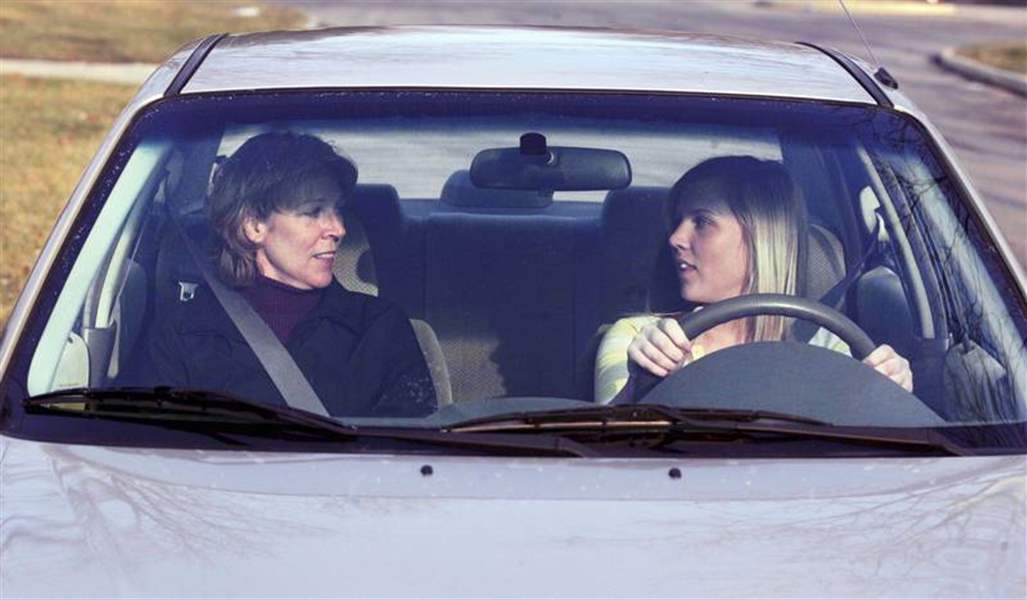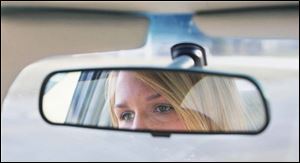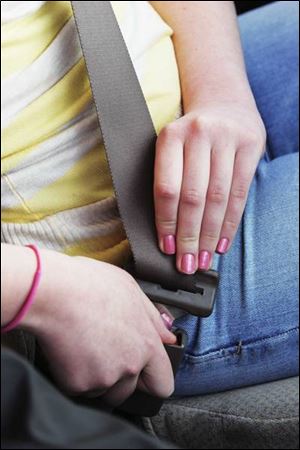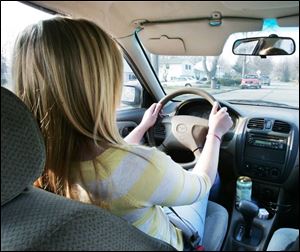
Teaching your teen to drive
4/1/2007
Haley Lancaster, 16, gets behind the wheel for some driving time with her mother, Sue Lancaster.

Haley Lancaster, 16, gets behind the wheel for some driving time with her mother, Sue Lancaster.
Haley Lancaster slips behind the wheel of the 1999 Mazda Protege she will share with her older brother, Aaron. Her mother, Sue Lancaster settles in the passenger seat.
As she manipulates through her Sylvania neighborhood, turning her head at intersections and slowing for speed bumps, Haley is a model new driver.
She s the third teen Sue and her husband, Tom Lancaster, have shepherded through this process, often viewed by teens as liberation and by parents as a source of trepidation.
The Handing Over of the Keys is a rite of passage, like lending a stabilizing finger to the baby taking her first steps, and holding on to the bicycle seat when she s learning to ride without training wheels. The consequences, however, are much bigger.

Haley Lancaster has learned some of the key safety habits, including frequent mirror checks.
In the 60 years or so since it s been a standard part of Americana, teaching and licensing teens has become increasingly complex, restrictive, and expensive.
For example, a minimum 50 hours of parent-supervised driving is required in Ohio and Michigan. And Michigan, with a three-year probation period, requires parents to submit their drive-time log and the driving contract they have with their teen.
The stakes are certainly higher: Speed limits have risen, cars are faster, penalties are stiffer, and more teens have their own rides. And there s that unfortunate statistic about the crash rate for teens being four times higher than for adults, and the horrific one about car accidents being the No. 1 cause of deaths for teens.

Haley Lancaster has learned some of the key safety habits, including using the seatbelt.
Given this charged atmosphere, meltdowns by parent and teen aren t unusual during driving lessons, but for everybody s well-being, parents can keep things calm by brushing up on their own skills (reading the teen s training material for starters) and having a plan. Indeed, most parent-teen driving contracts have provisions reminding parents to chill, such as I will provide respectful feedback when accompanying my teen driver, I will listen in a respectful manner to explanations or concerns expressed by my teen driver, and one that may require mopping up lousy habits (speeding, bumper-riding, snarling at other drivers): I will serve as a good role model when operating a vehicle.
Instructor Beverly Ricciardo says it s different teaching your own child than teaching strangers. She works at Toledo Driving Schools and is also teaching her teenage son.
You might be more on edge, a little louder, not as confident with your own child as with the students, says Ms. Ricciardo.
She suggests starting out in empty parking lots, cemeteries, or lightly-traveled rural roads, followed by quiet residential streets until the student masters basic manipulation and skills such as turning, starting, and braking at different speeds. Here they can begin building essential habits: frequent use of all mirrors, and the head-check, which means swiveling the head at intersections and before changing lanes.
The Ohio Department of Public Safety has a free guide for parents (see article on resources on Page 3) with ideas about what o accomplish in each outing. It recommends keeping the log in the glove compartment, limiting each session to less than an hour, not overloading information, and providing clear instructions far enough in advance (such as, Lift your foot off the gas and begin to brake. )

Haley Lancaster has learned some of the key safety habits, including frequent mirror checks and using the seatbelt.
Next comes work on stopping-distances, and looking in all directions, and scanning, which means continually projecting where the car will be 8 to 12 seconds from now.
Then, move up to light traffic, multiple-lane driving and passing, city, highway, night, and foul-weather driving.
Watch for common problems such as excessive speed, inattentiveness, distraction inside the car, poor defensive driving, incorrect assumptions about other drivers, and not keeping enough distance (three to four seconds is recommended) between cars.
Take it easy
Even after 50 hours of practice driving, many kids will not be ready to drive unaccompanied; if so, it s a parent s thankless job to summon their courage and say not yet to their champing-at-the-bit children.
No state has a perfect graduated license, but parents can create perfect licensing in their home, says John Ulczycki, executive director of the transportation safety group for the National Safety Council. Too many parents can t say no to their children.
He recommends 9 to 12 months of parental copiloting, including at least 20 hours at night (40 percent of teen accidents are after dark), and many trips in snow, rain, sleet, and on freeways. He s well aware that expanding the training period may cause considerable gnashing of adolescent teeth: he s taught five teens to drive and has one more to go, and insisted on the longer time frame for all of them.
When kids are small we gradually expand their boundaries. It s the same with driving, he says. Most kids don t get nearly enough experience.
Parents have to be comfortable with their child s abilities before allowing them to get a license. Driving is, after all, a privilege, not a right.
Most teen accidents are caused by inexperience in certain situations, and because they don t have a mature grasp on risk.
Teens just don t have that risk perception because they just haven t experienced it enough, says Mr. Ulczycki. They tend to follow too closely and they don t understand how long it takes to stop the vehicle.
Rules tightened
Teens do the exact opposite of adults when it comes to the number of passengers in a vehicle, he says: Adults drive more carefully with a bigger carload while teens drive more recklessly.
In the last decade, all 50 states have tightened rules for new drivers by establishing graduated driver s licenses aimed at building safer drivers. Both Ohio s and Michigan s graduated licenses are headed in the right direction but aren t among the nation s strongest, says Mr. Ulczycki. So far, graduated licenses appear to be saving lives.
Fatal crashes involving 16-year-old drivers in 2005 were at their lowest level since 1992, despite the highest national population of 16-year-olds (4.2 million) since 1977, according to research reports at a February National Safety Council symposium.
And how about those cell phones?
You can either get them a cell phone or a car, but not both, says Carlo Gibellato, a 31-year agent with Nationwide. He suggests parents arrange a meeting between their insurance agent and the youth.
My talk to young drivers is what to do when you have your accident, and hopefully it s a fender bender, says Mr. Gibellato. I tell them about the importance of being serious with the car. And the consequences of their actions are being paid for by their parents.
When his three children were in high school, he did not buy them cars. He noted that most European countries don t grant driving privileges until age 18. In his native Italy, new drivers must place a large P on the vehicle they re driving for a year, indicating their provisional status.
Haley Lancaster, a sophomore at Northview High School in Sylvania, plans to get a job to pay for her insurance and she hopes to qualify for a good-student discount.
The hardest part of learning to drive, she says, has been trying to anticipate what other drivers might do. Driving at high speed has not been as challenging as she expected.
I like it, she says. I already have a sense of freedom.
Adds her mother, We ll start with short trips.
Contact Tahree Lane at: tlane@theblade.com or 419-724-6075.